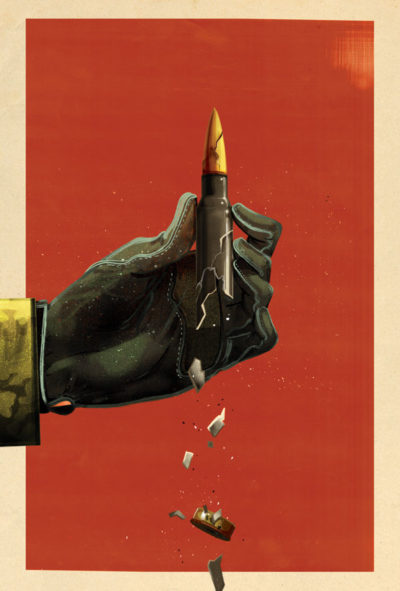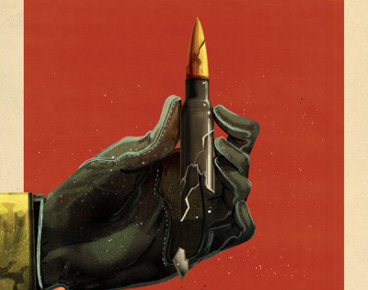The death of Moammar Gadhafi last fall brought 42 years of oppressive rule to an abrupt and bloody end. For their part in eliminating this tyrant, NATO deserves thanks from the world in general and the Libyan people in particular. However, this praise is tempered by the enormous weaknesses revealed within NATO, particularly in the stock of precision ammunition—computer-guided missiles and bombs —so vital to success. Within weeks of the start of operations, Britain, Italy, and France had depleted their stocks of precision munitions without Gadhafi showing any signs of surrender. A reluctant Germany was finally convinced to break open its war reserves, but even that proved insufficient. In the end, emergency shipments from the U.S. allowed our European allies to continue their campaign.
Although American stocks of materiel were sufficient for tackling Libya, they are far from inexhaustible. In fact, the U.S. military remains critically short of these same types of weapons. Early in the Iraq war, for instance, stocks of precision bombs were so reduced that the Pentagon ordered Boeing to ramp up emergency production. Boeing’s attempts to supply the military’s needs were thwarted by a Swiss company, Micro Crystal, which—angered by the U.S. decision to invade Iraq—ceased delivery of a key part, according to defense officials. Because no firm in the U.S. made the part, finding an American company capable of starting a new production line took the Pentagon seven months. If the most powerful military in the world could run short of a key weapon system against a third-rate military power like Iraq, what would happen if we faced a more powerful opponent such as China?
In the last century, American industrial might twice rescued the democratic world: first from German militarism and then from Axis totalitarianism. After World War I, one of Germany’s top military commanders claimed that his country was not beaten by the Allied military but by “pitiless American industry” that was able to mass produce war materiel on a previously unimaginable scale. Two decades later that same “pitiless industry” became President Franklin Roosevelt’s “Arsenal of Democracy,” which buried the Axis powers under an avalanche of war materiel belched out of Pittsburgh’s furnaces and Detroit’s assembly lines. Sadly, those days are relegated to the past. As American heavy industry has moved off shore, so has much of the nation’s ability to mobilize the kinds of forces that met the crises of the last century.
Despite rumors to the contrary, however, America still possesses a formidable industrial base. Unfortunately, it is no longer unrivaled by other growing powers. Every passing year sees China further solidifying its position as the world’s production base. According to the Pentagon’s 2011 annual report to Congress on Chinese military developments this “sustained economic development … coupled with an expanding science and technology base, has facilitated a comprehensive and ongoing military modernization program.”
Knowing this, one cannot help but wonder if the U.S. industrial base is still capable of winning the production war in a major conflict. Meanwhile, there is another looming threat that is only beginning to be understood—the globalization of supply chains. In today’s globalized economy a weapon may consist of parts from a dozen or more countries that come together at a single assembly point. At least 50 percent of all of content in any item bought by the Department of Defense must, by law, come off American production lines, and some weapons are 100 percent made in the USA. Still, in certain cases, parts are made in America, shipped to China for assembly, and then shipped back to the U.S. for sale. This presents America’s high technology military with a major problem.

Then, there is the potential for sabotage anywhere along the supply chain. For instance, many of the microchips purchased for the Pentagon come from China, where they theoretically could be tampered with by Chinese intelligence. And, in fact, in 2010 alone the U.S. Navy purchased more than 59,000 computer chips from China that were discovered to be counterfeit. These chips were destined for use in our most sensitive weapons systems—from missiles to transponders, as reported in Wired magazine. Any or all of these chips could have included malware that would allow the Chinese military to turn off or otherwise wreck whatever systems the chips were inserted within. After counterfeit chips were discovered, the Intelligence Advanced Research Projects Activity initiated the Trusted Integrated Circuit Program both to help prevent foreign adversaries from tampering with U.S. chips and to check foreign-sourced chips for flaws after delivery.
But the problems don’t end there. The Pentagon is expecting huge budget cuts as a result of our current wars ending and the nation’s dire economic position.
For this reason, America’s defense industry is scrambling to reduce capacity.
Northrop Grumman, a global aerospace and defense technology company, recently announced plans to close troubled shipyards and leave the shipbuilding industry. This means that one of the country’s five remaining naval shipyards—Avondale—could close for lack of work with a loss of 5,000 jobs.
With those jobs goes decades of shipbuilding experience that will be near impossible to replicate if it is needed in an emergency.
Today U.S. shipyards produce less than one percent of all commercial vessels while Asia builds 95 percent. Without the naval shipyards America would effectively be exiting the shipbuilding business entirely, a sad end for an industry that in World War II produced ships six times faster than Hitler’s submarine wolfpacks could sink them.
In the meantime, China has the capacity to build almost 60 million tons of ships per year and is looking to increase that capacity, according to the East Asian Institute at the National University of Singapore.
In the end, if America loses a future war because of production shortfalls that leave our soldiers, sailors, airmen, and Marines bereft of what they require to fight and win, it won’t be because we lack the capacity. America’s ability to win the wars of tomorrow rests on implementing the economic policies necessary to rebuild our industrial base and ensure the availability of funds required to meet an unforeseen crisis.
READY, FIRE, AIM
Poor planning and budget cuts mean more challenges for the military.
The outsourcing of U.S. industry is a serious national security problem—but it’s not the only problem. Other threats include:
Slashed budget.
With America’s heavy debt burden and a deadlocked Congress, huge cuts in funding loom in the Pentagon’s future. America’s production miracle in World War II was the result of a growing economy and not, as myth would have it, a radical reduction in consumer production in favor of war munitions. Although Americans could not buy big ticket items like new cars, consumer spending rose almost every year of the war. A huge number of unemployed workers and a huge amount of excess capacity brought about by the Great Depression made the American production miracle possible. And, despite the Depression, America’s Federal debt was still low, allowing the U.S. to borrow the hundreds of billions necessary to turn the nation into the “Arsenal of Democracy.” By 1943 America’s output in war materiel alone was more than the nation’s entire economy produced in the year before the war. The U.S. financed its unparalleled wartime growth on a sea of dollars, which increased our national debt from around 40 percent of gross domestic product (GDP) to over 120 percent by 1945. Today, the nation would start any conflict with debt levels already exceeding 100 percent of GDP, and it probably couldn’t finance another supreme effort without collapsing an already fragile financial system.
Weak policy.
A major threat to the military comes not from abroad, but from domestic policymakers who knowingly or unknowingly undermine the mission of armed forces. The U.S. was once the leading producer of “rare earth minerals,” specialty metals crucial for high-performance aircraft and weapons. Due to challenges by the environmental lobby, U.S. rare earth production ceased a decade ago. As a result, China, potentially our most formidable long-term rival, produces 97 percent of the world’s rare earth minerals. In effect, the U.S., of its own free will, has pushed a global superpower into a monopoly position, and China is already beginning to use its dominance to curtail global supply. According to a 2011 Pentagon report to Congress, the Defense Department, already paying 40 percent more for these minerals than it did a year ago, considers this a serious risk, stating it “relies on rare earth materials in the production of many of its weapon systems and needs to ensure their continued availability to meet national security objectives.”
Jim Lacey, Ph.D., is the professor of strategic studies at the Marine Corps War College. The opinions presented here are entirely his own and do not represent those of the Department of Defense or any of its members.
Become a Saturday Evening Post member and enjoy unlimited access. Subscribe now



